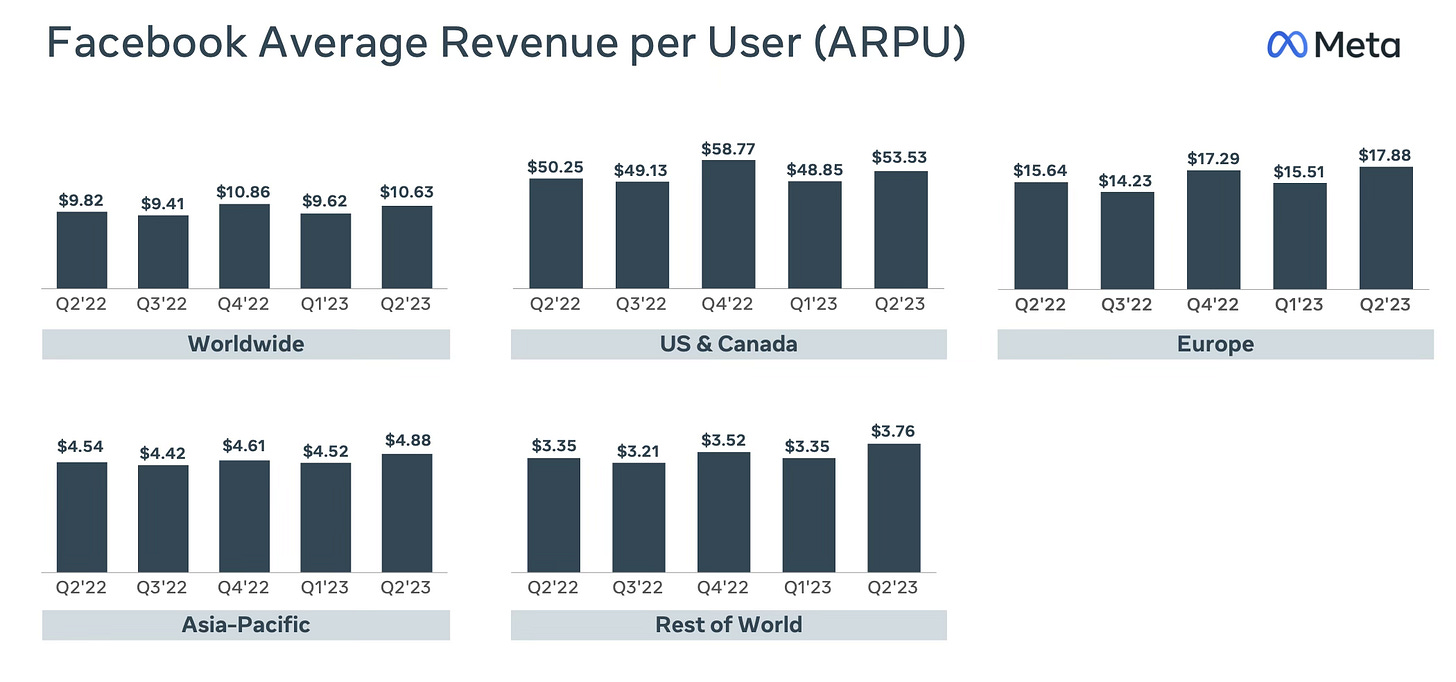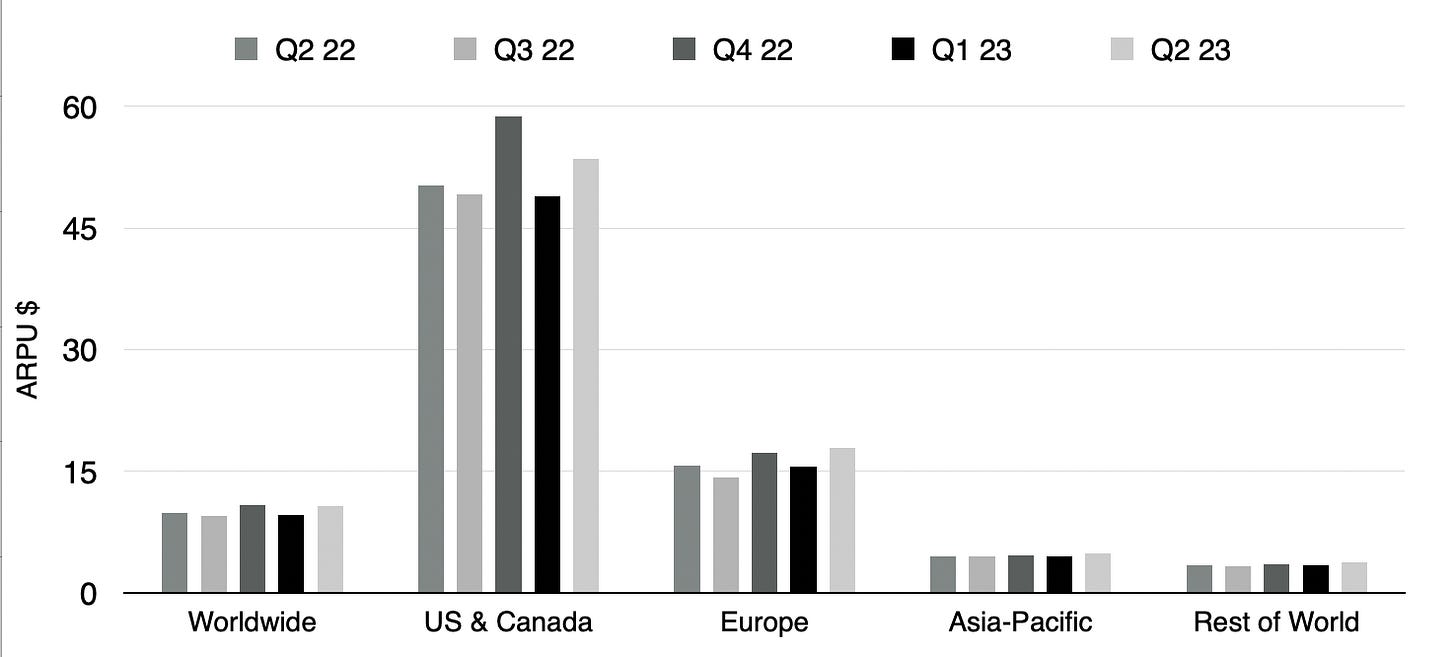
We return to the vexed question of how much you would pay for an ad-free experience on the social platform of your choice. Previously I looked at the possibility that Twitter/X would introduce a mandatory subscription. But following the befuddling interview with alleged Twitter/X CEO Linda Yaccarino at Code23 at the end of September, it’s impossible to know whether this will happen: confronted with the question, Yaccarino at first looked as though she’d been hit by a plank, then asked for the question to be repeated, and then diverted for several minutes and successfully avoided giving anything resembling an answer. So we don’t know.
However, Meta is considering introducing an optional subscription in the EU for Facebook and/or Instagram or both. Simultaneously, TikTok has confirmed that it’s going to test an ad-free “subscription tier”.
What gives rise to something of a double-take is the pricing delta. According to the WSJ, which reported on the Facebook/Instagram plan,
Would people pay nearly $14 a month to use Instagram on their phones without ads? How about nearly $17 a month for Instagram plus Facebook—but on desktop?
That is what Meta Platforms wants to charge Europeans for monthly subscriptions if they don’t agree to let the company use their digital activity to target ads, according to a proposal the social-media giant has made in recent weeks to regulators.
The proposal is a gambit by Meta to navigate European Union rules that threaten to restrict its ability to show users personalized ads without first seeking user consent—jeopardizing its main source of revenue.
…Under the plan, Meta has told regulators it would charge users roughly €10 a month, equivalent to about $10.50, on desktop on a Facebook or Instagram account, and roughly €6 for each additional linked account, the people said. On mobile devices the price would jump to roughly €13 a month because Meta would factor in commissions charged by Apple’s and Google’s app stores on in-app payments.
That’s quite some front, isn’t it? Looking to charge as much as Netflix or Disney+, more than twice as much as AppleTV+, more than NowTV’s entertainment package, so you can scroll through and see posts from influencers but without the distraction of those ads for things which, like the items in the Aldi Middle Aisle, have a 50/50 chance of being indispensable or ending up in the back of a cupboard. Or Facebook as well—though only on desktop, then you start having to pay more to have it on your phone?
Compare and contrast with TikTok, which told Techcrunch that it’s going to start testing a “subscription tier” that removes ads, “but only in a single, English-speaking market outside the US”. I’ve puzzled over which market that could possibly be, and alighted on a grand total of four principal ones, and a score of rather smaller others. The principal ones are Canada, the UK, Australia and New Zealand. The others are former British colonies that aren’t the US—think of Caribbean islands, or some of the Pacific ones. (I know, there’s an overlap between the first and second group.) And the price those lucky souls will be asked to pay? Just $4.99 (or equivalent) per month.
The use of the dollar in the screenshot grabbed from the TikTok code narrows things down usefully: if we’re talking English-speaking, it can’t be the UK, but could be Anguilla, Antigua and Barbuda, Australia, the Bahamas, Barbados, Belize, Bermuda, the British Virgin Islands, Canada, the Cayman Islands, Chatham Islands, Christmas Island, the Cocos Islands, the Cook Islands, Dominica, Grenada, Guam, Guyana, Jamaica, Kiribati, the Marshall Islands, Micronesia, Montserrat, Nauru, New Zealand, Niue, Norfolk Island, the Northern Mariana Islands, the Pitcairn Islands, St. Kitts-Nevis, St. Lucia, St. Vincent and the Grenadines, Tobago, Tokelau, Trinidad, the Turks and Caicos Islands, and Tuvalu.
Take your pick. I’d have thought Australia or New Zealand were good candidates: at the end of 2022 there were an estimated 7.4 million TikTok users in Australia, with an ad reach of one-third of the local internet user base; in New Zealand, the same research company puts the TikTok user base at 1.5 million, with the same one-third ad reach of local internet users. Based on that, Australia seems the better choice. But surprise us, TikTok! Maybe it will be Christmas Island.
The difference in price is quite amazing, though, isn’t it. Is there any way in which Meta can possibly justify charging that much? As in, is the revenue lost in ads not viewed the same as it’s charging? Or, put another way, do European users consume $14 worth of ads per month on Instagram?
Fortunately, we can figure this out. Meta’s quarterly results include a slide presentation showing its user revenues by geography.
Here’s the slide for Facebook’s ARPU by territory. Look at it for a moment, and see if you can spot the sleight of hand the graph designer has pulled off.
Did you spot it? Look again at the separate graphics, and at the numbers, and mull over the fact that this must one of the most egregious misuses of graphics—in particular the Y-axis—that’s ever been committed to a filing to the SEC. Well, since the last one from Meta. (If you know of worse, please tell me.) Found it yet?
Here it is: the US ARPU figure is roughly five times bigger than the “worldwide” number, and three times bigger than the European one. But they’re scaled to make it look as though they’re all almost equal. You could almost think that the US/Canada is about the same as Europe in ARPU terms. No, it is not. Honestly, it deserves this:
(Bonus, though irrelevant, point if you can name this Game Of Thrones actress and which part she played in a subsequent, very successful, TV series1.)
If the graphic were drawn honestly, it would look like this:
One key point to note is that the ARPU per quarter in Europe (which includes the UK, for Meta’s purposes) only hovers around $17 per quarter. So to generously offer to charge $14 per month, or $17 per month for both, is clearly a bad deal for the user: they’d be charged about three times more than Facebook actually gets from showing them advertising. So if you’re offered it, don’t take it. Just swipe a bit faster.
What I don’t know is whether the EU can reject this proposal on the basis that, as the calculation above shows, it’s ridiculous and demonstrates that Meta/Facebook isn’t making a serious offer. The WSJ story notes:
It isn’t clear if regulators in Ireland or Brussels will deem the new plan compliant with EU laws, or whether they will insist Meta offer cheaper or even free versions with ads that aren’t personalized based on a user’s digital activity.
The scheme is meant to find a method to comply with the Digital Markets Act, which specifies that a user who declines to let their data be used in certain ways (eg targeted advertising) must still be able to access the service. I’d expect a certain amount of horsetrading, with Meta aiming to be bargained down to the place it wants to get to, ie a $5 per month paywall for those who don’t consent, and the EU insisting that people should be able to just opt out of being tracked and get “not necessarily relevant” ads. (Note in passing how Apple’s App Tracking Transparency does most of the work of the DMA, by stopping you being tracked individually if you want). After all, it’s not as though we don’t give Facebook or Instagram any useful signals usable for ads simply by the content we consume: who you choose to follow, what you choose to watch, how long you spend on it, all provides exactly the sort of signal that the algorithm needs to figure out what to show us; which goes for adverts too.
That neatly brings us to TikTok’s plan for a $4.99/month scheme, which by remarkable coincidence is $14.97 per quarter—about the same as Facebook’s ARPU in Europe. (Hmm, none of the potential countries listed above is in Europe.) That, too, looks a bit ambitious. TikTok doesn’t publish accounts as Meta does (not even ones with suspicious graphs), but there are plenty of estimates about its revenues and users. According to Business of Apps, the app has about 1.7 billion MAUs, and generated about $9.4bn in revenues in 2022. Simple maths points out that that’s just $5.53 per user per year; taken on a per-month basis, it’s less than $0.50.
In which case the proposed $5/month subscription fee, while it might sound reasonable compared to Meta’s outrageous one, is actually even more moneyraking: it’s ten times greater, rather than a pootling three.
Even if you think that the breakdown of revenues geographically follows the same pattern as Meta—where the US+Canada/ Europe/ Asia-Pacific/ Rest of World ratio is 68/ 21/ 6/ 5, and you think that US users of TikTik generate an ARPU so much larger than others, you’d only scrape by in justifying that $5 charge to US+Canada users.
From which we conclude—what? I think we can learn a couple of things. First, that these companies are truly shameless when it comes to setting prices on their products. They greatly exaggerate the value that they extract from us; if free services generate consumer surplus, these are seeking consumer deficit (aka producer surplus, overcharging for products).
And second, the end of ZIRP (zero interest rate policy) means we’re seeing an odd convergence by technology and internet-based companies from opposite directions: the free ad-supported ones are experimenting with going ad-free for money (see above), while the ad-free paid-for ones are experimenting with offering cheaper tiers based around ads (hello Netflix and Amazon Prime Video). Perhaps this means that everyone is converging on freemium again. (Did they ever stop?)
But we need to know that we’re getting value for money. And we need to be honest about how valuable our time is. If Facebook or Instagram can’t monetise it for that much, we shouldn’t pay that much for it.
Glimpses of the AI tsunami
(Of the what? Read here. And then the update.)
• Bing Image Creator lets you create only images that aren’t blocked in one way or another: no humans, no images of terrorism, violence of hate speech. Hasn’t stopped people generating images showing various cartoon characters flying a plane.. towards the Twin Towers, a la 9/11 attack.
• Meta lets you generate, via a prompt, stickers for Messenger. Oh dear: child soldiers is only the mildest thing.
• Google’s new Pixel lets you generate wallpapers from a selection of prompts. Good work limiting the possibilities, people.
• Deepfakes in Slovakia’s election got past Meta’s policy because they were audio, not video. Also, a deepfake of money distributor Mr Beast pretending he’s doing a huge iPhone giveaway. (He isn’t.)
• A nine-billion parameter model for autonomous driving. OK, this isn’t quite AI content, but it is a sign of how AI is creeping up on us, into everything we touch.
• I won my three-year AI progress bet in three months. Scott Alexander, of SlateStarCodex, had a challenge involving five prompts such as “A stained glass picture of a woman in a library with a raven on her shoulder with a key in its mouth” and “An oil painting of a man in a factory looking at a cat wearing a top hat”. He reckons they’re essentially there.
• Ryan Broderick muses on AI-based “chumbox” spam (those junk links at the bottom of otherwise worthwhile stories):
I’m struck by how clear it is now, in retrospect, how the entire era of “viral media” that defined the 2010s was really just the death gasps of 20th-century mass media. These sites dressed themselves up as something new and bold and hired a lot of talented young people who “got the internet,” but it was just a temporary solution. And that’s especially clear now that many of the big sites of the 2010s are replacing human writers with AI and many of the formats that defined Peak Facebook have now turned into their own form of spam.
• The Messenger, the news website nobody has ever knowingly read, is partnering with Seekr, “a revolutionary artificial intelligence company specializing in transparent content evaluation”, and that
The technology – which currently powers Seekr's consumer-facing platform at Seekr.com – spots instances of clickbait, title exaggeration, subjectivity, and personal attacks, among other departures from the standards; it can detect the absence of a byline, inferior sourcing and attribution, and whether website ownership information is transparent and credible.
Essentially nobody thinks this will help The Messenger grow its reader. In fact, could be the opposite. If your website is only read by an AI, can you sell ads on it?
• You can buy Social Warming in paperback, hardback or ebook via One World Publications, or order it through your friendly local bookstore. Or listen to me read it on Audible.
You could also sign up for The Overspill, a daily list of links with short extracts and brief commentary on things I find interesting in tech, science, medicine, politics and any other topic that takes my fancy.
• I’m the proposed Class Representative for a lawsuit against Google in the UK on behalf of publishers. If you sold open display ads in the UK after 2014, you might be a member of the class. Read more at Googleadclaim.co.uk. (Or see the press release.)
• Back next week! Or leave a comment here, or in the Substack chat, or Substack Notes, or write it in a letter and put it in a bottle so that The Police write a song about it after it falls through a wormhole and goes back in time.
The delicious Hannah Waddingham, who played football club owner Rebecca Welton in Ted Lasso.






On prices in the digital ecosystem .. I think we're moving into a new world.
Increasingly decisions are made by consumers who never pulled out a wallet and hand it over green stuff. It's just another question and click.
It has reduced salience that it's even "money" or has anything to do with the future wealth or welfare.
At this point how many consumers don't even know how many subscriptions they have?
It took me a while to remember, but the bit about charging by device reminded me of something.
It's the way the in the early days of licencing digital music, some services tried to tie an MP3 music track to one device. I suspect they were addicted to what happened with CD's, i.e. people replacing their vinyl collection ad £14 a pop, for music they'd already bought.
That was doomed to fail and this is too.